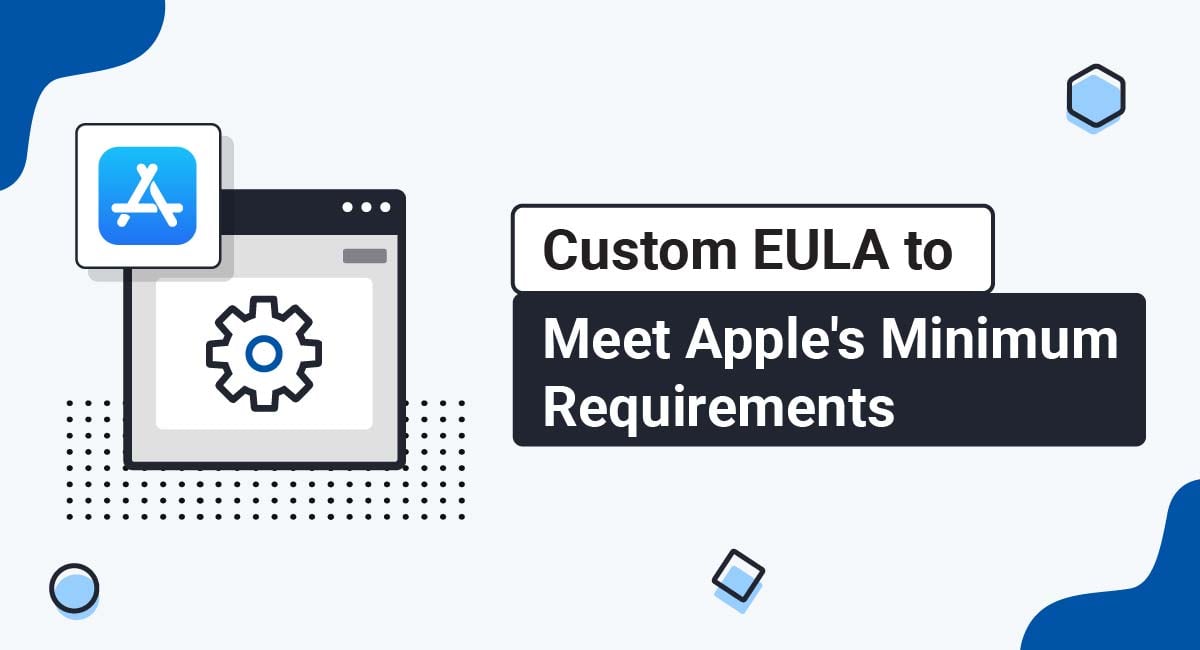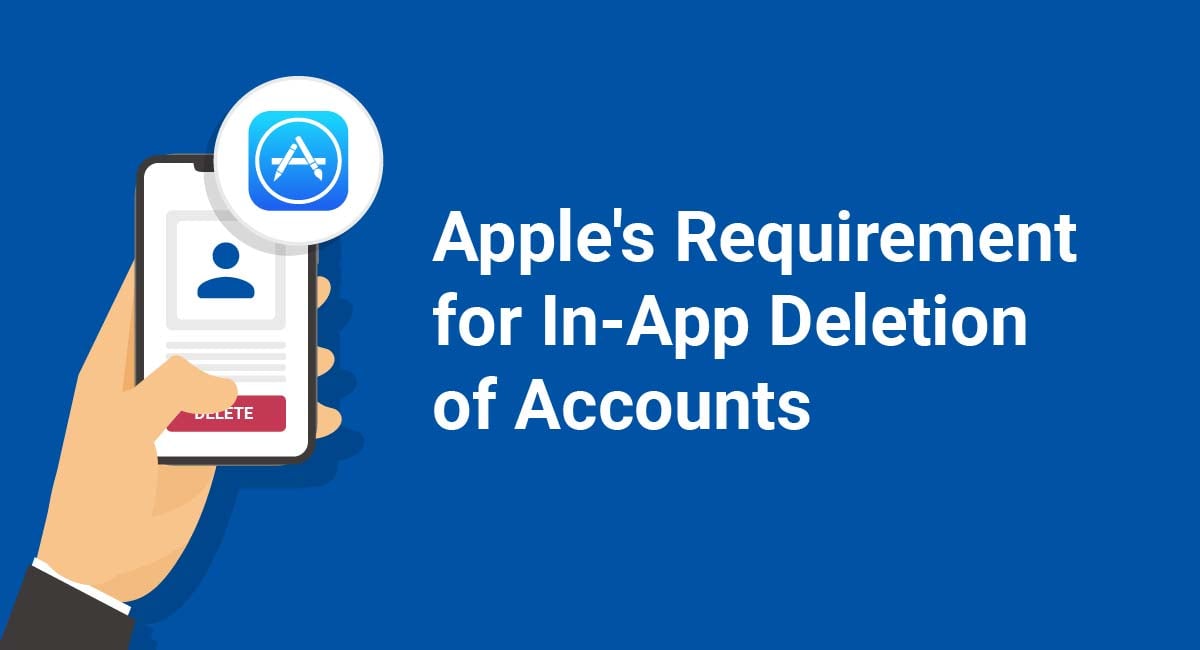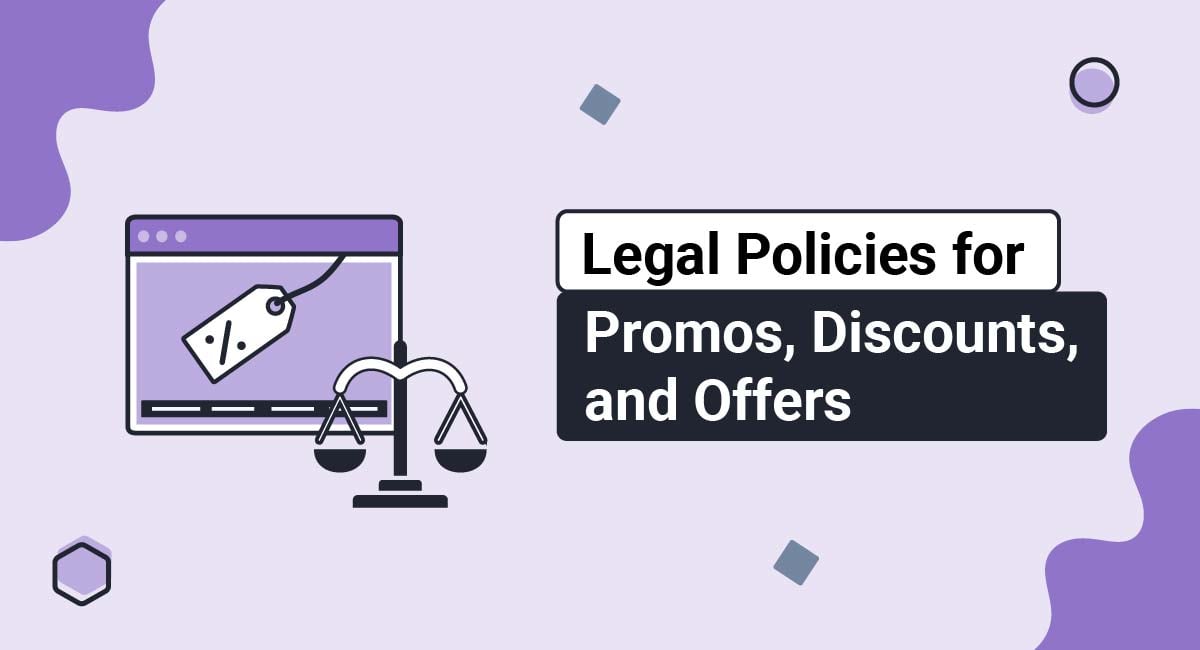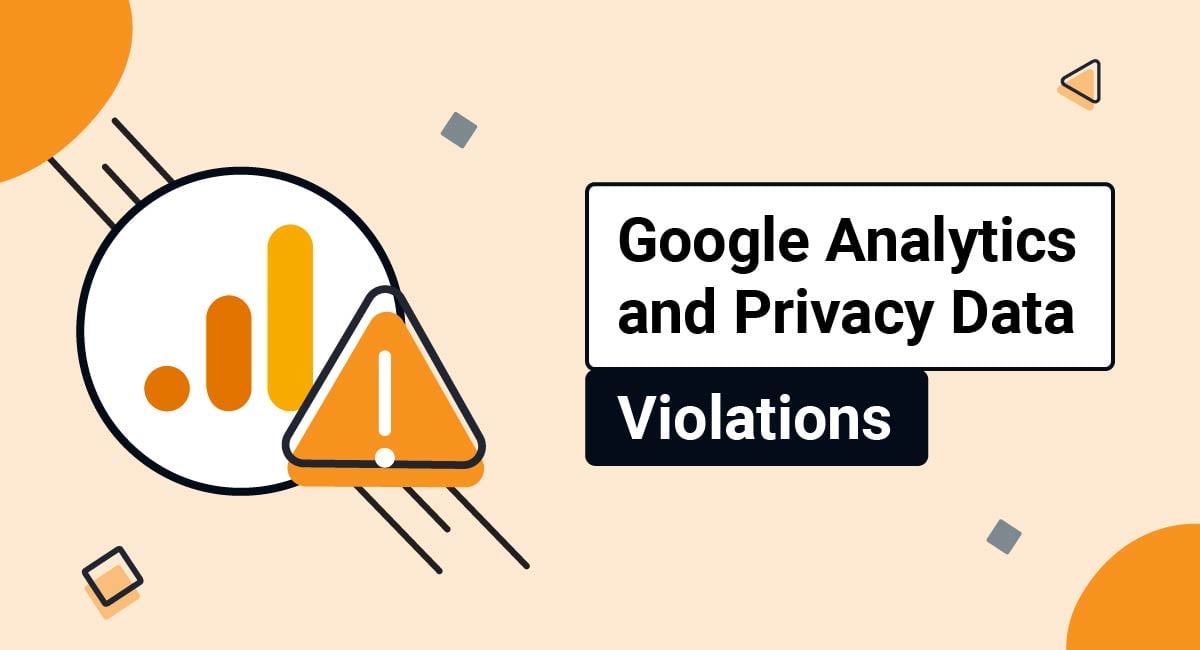While Apple provides a default EULA that you can choose to use for your iOS app, you may prefer to create a custom EULA. If you go this route, your custom EULA must meet 10 requirements.
This article will explain what Apple requires, and how to create your own custom EULA to satisfy those requirements.
Our EULA Generator makes it easy to create an EULA. Just follow these steps:
-
At Step 1, select the Desktop app option and click "Next step":
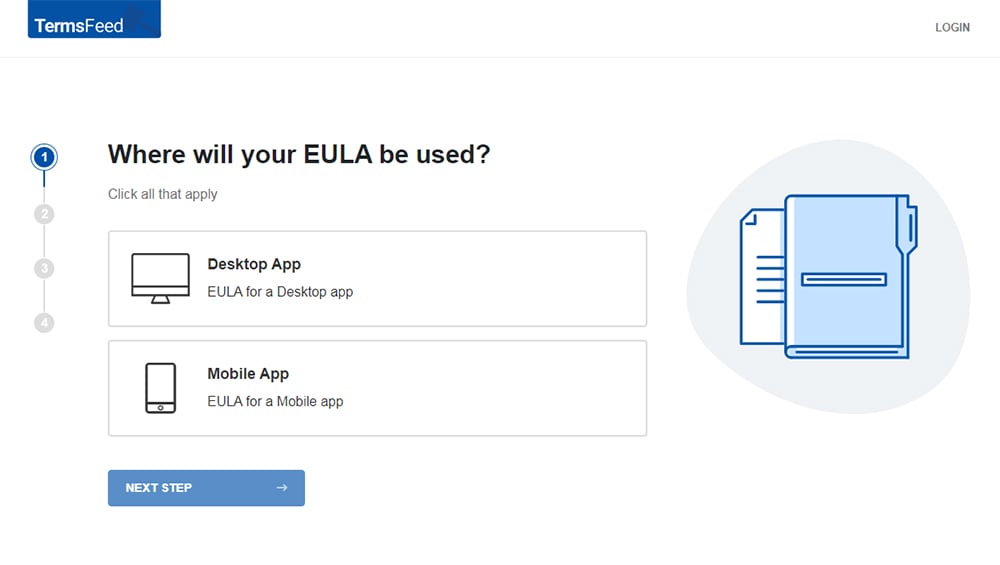
-
Answer some questions about your app.
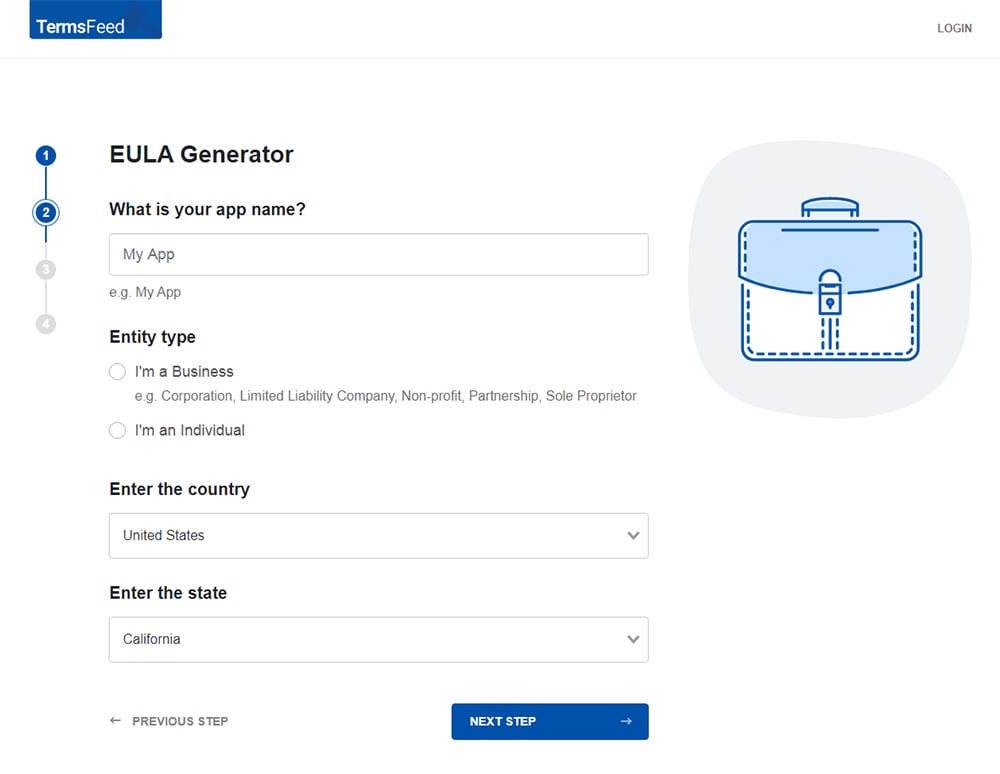
-
Answer some questions about your business.
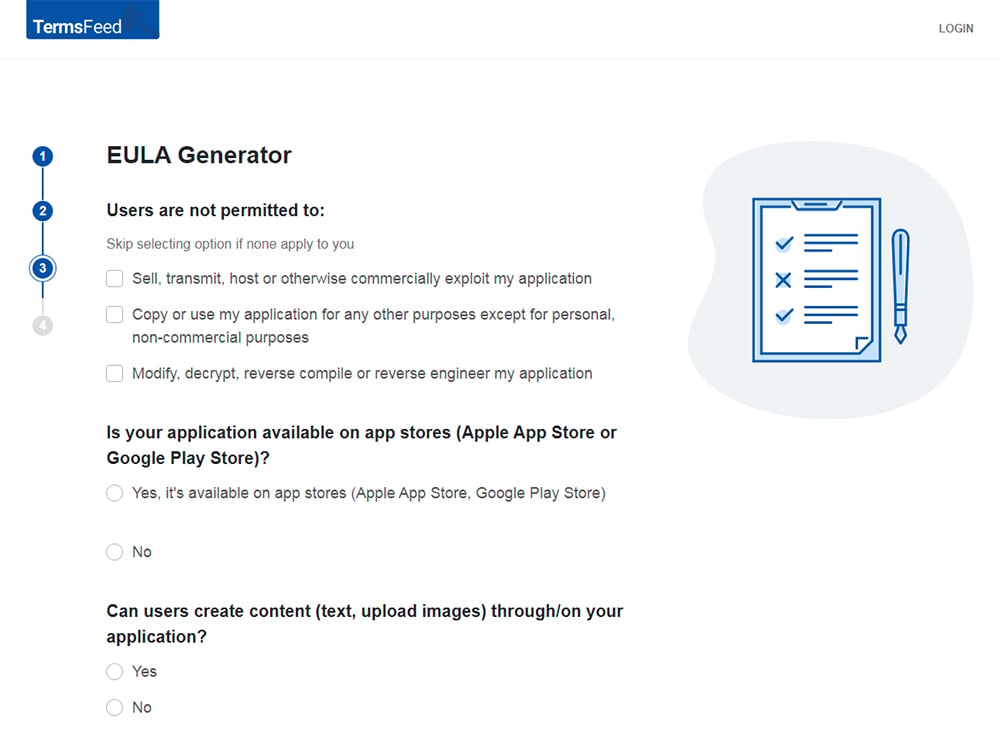
-
Enter the email address where you'd like to receive the EULA document and click "Generate."
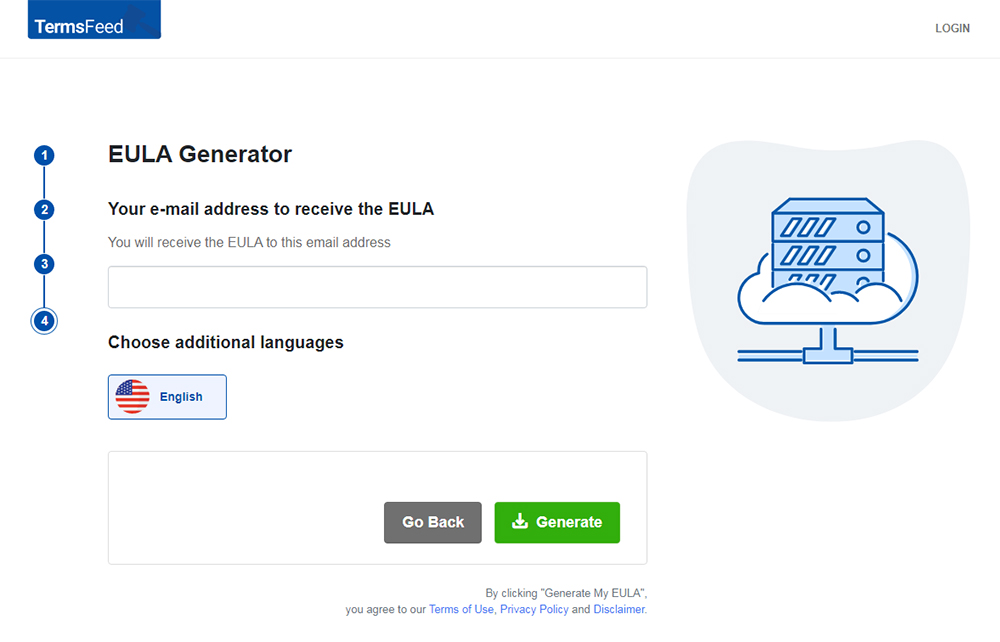
You'll be able to instantly access and download your new EULA.
- 1. What's an EULA
- 1.1. Terms and Conditions vs. EULA
- 2. When Apple's Default EULA Applies
- 3. Why Create a Custom EULA
- 3.1. More Control Over Terms
- 3.2. Additional Clauses
- 3.3. More Detailed Terms
- 4. Apple's Requirements for a Custom EULA
- 4.1. 1. Acknowledgement
- 4.2. 2. Scope of License
- 4.3. 3. Maintenance and Support
- 4.4. 4. Warranty
- 4.5. 5. Product Claims
- 4.6. 6. Intellectual Property Rights
- 4.7. 7. Legal Compliance
- 4.8. 8. Developer Name and Address
- 4.9. 9. Third Party Terms of Agreement
- 4.10. 10. Third Party Beneficiary
- 5. How to Add a Custom EULA to Apple App Store Connect
- 6. Summary
What's an EULA
An EULA - also known as an EndUser License Agreement - is commonly seen in software applications. The EULA works as the contract between the software end user and the licensing company. It's similar to a Terms and Conditions for websites (also known as Terms of Use or Terms of Service).
It's where the user is granted a license to use the software, and where limitations to that licensed use of the software are presented such as restrictions on reverse engineering.
Terms and Conditions vs. EULA
Terms and Conditions agreements are the ground rules for using your app, while the EULA deals with licensing and ownership rights.
The confusion lies in that both agreements deal with the concept of use. However, each addresses use differently.
When you discuss use within a Terms and Conditions agreement, it will address topics like what types of shows users can stream or data users can access.
In the EULA, however, the use focuses more on the possibility of misappropriation or the act of using another's property as personal gains (the user).
With streaming shows, for example, the Terms and Conditions agreement will tell the user what she/he can access, but the EULA will explain that she/he cannot make that show available somewhere other than that app.
That is why companies with specific proprietary information prefer to maintain an EULA in addition to the Terms and Conditions agreement.
Your mobile app may give a party the ability to watch games, record calls or use software suites, but the EULA will protect those functions from being manipulated by a user for her/his personal gain.
When Apple's Default EULA Applies
Apple's default EULA automatically applies when you, as an iOS mobile developer, do not provide your own licensing agreement.
If you decide to leave this standard agreement in place and not replace it with a custom agreement, the users of your app will automatically agree to it when they download your mobile app.
Apple's standard EULA includes all of the most common and generally required sections and clauses including warranty disclaimers, limitations of liability, termination, license scope and a governing law clause.
However, a lot of developers do choose to create a custom EULA rather than using Apple's, and here's why.
Why Create a Custom EULA

There are a few reasons why a developer may choose to create his own custom EULA for his apps instead of using this one.
More Control Over Terms
While having a default EULA is better than no EULA, creating your own custom EULA lets you have as much control as you want over your agreement terms. You can decide what you want to include in your EULA terms and specifically list them out.
If your app has unique limitations, special warranties included or other atypical terms, going custom can be beneficial and desirable.
Additional Clauses
A default EULA will be designed to apply to any app. Your custom EULA can include more clauses and terms that are custom to your specific app.
These additional clauses are a reason why many developers choose to create a custom EULA with more complex apps.
More Detailed Terms
You can get as detailed as you want to in your custom EULA. If you really want to limit specific behavior, activity and set forth other restrictions, a custom EULA will let you do this better than a default EULA. A default EULA may be vague in an area you would rather be detailed with.
For example, the NBA has a very robust EULA for its mobile apps.
Apple's standard EULA would adequately transfer the license to users of the NBA app, but there's no way users would be able to know from the standard EULA that so many affiliates and subsidiaries are involved and that the NBA holds so many trademarks, copyrights, patents and other intellectual property it protects in its EULA.
This additional and customized information and detailed EULA puts end users on notice about subsidiaries as well as the extent of the NBA's licensing reach and copyright holding.
Apple's Requirements for a Custom EULA

If you do choose to go with a custom EULA instead of Apple's default one, you're going to have to follow Apple's Instructions for Minimum Terms of Developer's End-User License Agreement guidelines.
The instructions include the following 10 requirements for an EULA. Each requirement from Apple is included as well as an example from a mobile EULA that meets Apple's requirements.
1. Acknowledgement
Your custom EULA must let end users know that the agreement is solely between them and you, and not with Apple.

Start by saying that the agreement is between the user and your company, and not Apple. State that your company and not Apple is solely responsible for the app and its content.
You can do this by saying something such as, "This Mobile Addendum is between you and business name here only, and not Apple, Inc. Business name here, not Apple, is solely responsible for the iOS App and its content."
Here's an example of such a clause from Lowe's:

2. Scope of License
Let end users know that the license they're getting is limited, revocable, and non-transferable, and that it can be used only on Apple devices the user owns and controls, and only as permitted by the Apple App Store Terms of Service.

Lowe's includes a License and Restrictions clause that accomplishes this:

3. Maintenance and Support
You must acknowledge that Apple has no obligation to provide maintenance or support for your app, and let users know if you provide any support.

Lowe's accomplishes this by including a statement that says, "You acknowledge and agree that Apple, Inc. has no obligation whatsoever to furnish any maintenance and support services with respect to the Application."

You can state that you do provide maintenance and support, if applicable, but remember to state that it's you and not Apple who provides it.
4. Warranty
If you offer any warranties for the app, you will be solely responsible for the warranties - not Apple.

Even if you disclaim all warranties, still note to the user that Apple is not responsible for any warranties.
Here's how Lowe's does this by disclaiming warranties "on behalf of Apple, Inc." in its Warranty Disclaimer clause:

5. Product Claims
Let end users know that Apple is not responsible for any claims related to the application or the end user's possession and/or use of the app, "including but not limited to: (i) product liability claims; (ii) any claim that the Licensed Application fails to conform to any applicable legal or regulatory requirement; and (iii) claims arising under consumer protection, privacy or similar legislation."

You can include this phrasing exactly as it reads in Apple's Instructions because it's standard phrasing used across industries.
Lowe's addresses this in two areas of its License Agreement. First, it includes this notice in its Limit of Liability clause:

It also notes this again in its Contact clause:

6. Intellectual Property Rights
Let users know that if your app allegedly infringes on any third party intellectual property rights, you and not Apple will be responsible for the "investigation, defense, settlement and discharge" of any such claims.

Here's how Lowe's states this in its Reservation of Rights clause: "In the event of an intellectual property claim that the Appication or your possession and use of the Application infringes on a third party's intellectual property rights, Lowe's, not Apple, Inc., reserves the right to investigate, defend, settle and discharge of any such intellectual property infringement claim."

7. Legal Compliance
You must request that your end users represent and warrant that they aren't located in a country that's subject to a U.S. government embargo, designated as a "terrorist supporting" country by the U.S. government, and that the user isn't on any U.S. government lists of prohibited or restricted parties.

Lowe's addresses this as follows:

8. Developer Name and Address
Add the developer's name, physical address, and some sort of contact information such as an email address or telephone number where end users can direct questions, complaints, or claims.

This is commonly included at the very bottom of an EULA in a "Contact" clause.
9. Third Party Terms of Agreement
Let end users know that they must comply with third party terms and agreements when using your application along with other third party apps or services.

For example, if you have a VoIP app, the end user must not violate their wireless data service agreement when using your app.
Lowe's includes this at the end of its very first introduction clause to emphasize its importance:

10. Third Party Beneficiary
Include a clause that lets end users know that Apple will have the right as a third party beneficiary to the EULA to enforce its terms against the end user if need be.

Lowe's includes this information in its General clause:

How to Add a Custom EULA to Apple App Store Connect
- Log in to your Apple App Store Connect account.
- Select your app:
- Under the General secton, select App Information:
- Scroll down to the License Agreement section. Click Edit:
- In the Edit License Agreement modal, select the second option: Apply custom EULA to all chosen countries and regions:
- You'll see the field for adding a Custom License Agreement and an option to select the countries or regions where it applies:
-
Add the text of your EULA in the Custom License Agreement field.
If you do not have an EULA, you can use our EULA Generator and create one within minutes.
- Once you have the EULA created by TermsFeed, let's get the policy text. You can download the Plain Text file format:
- Paste your custom EULA text in the field box:
- Click Done:
- Click Save to update the app information:
- You're done.
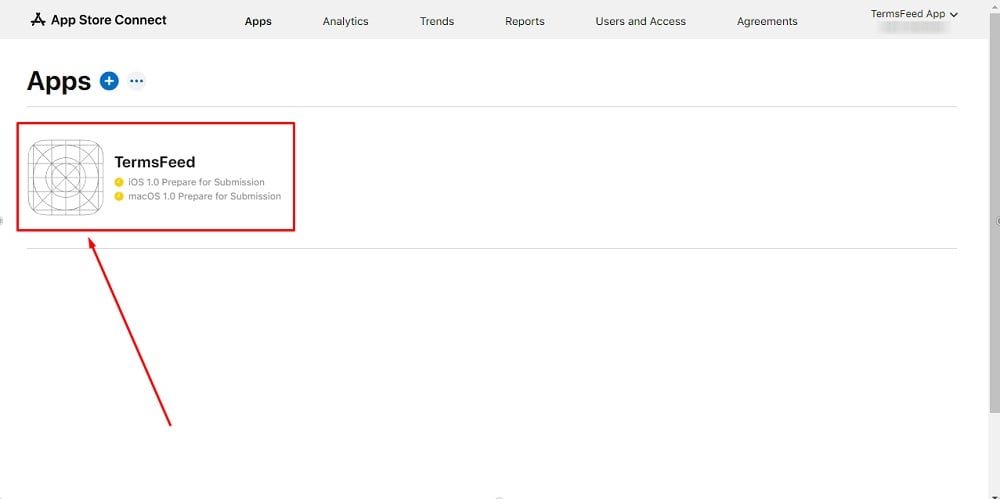
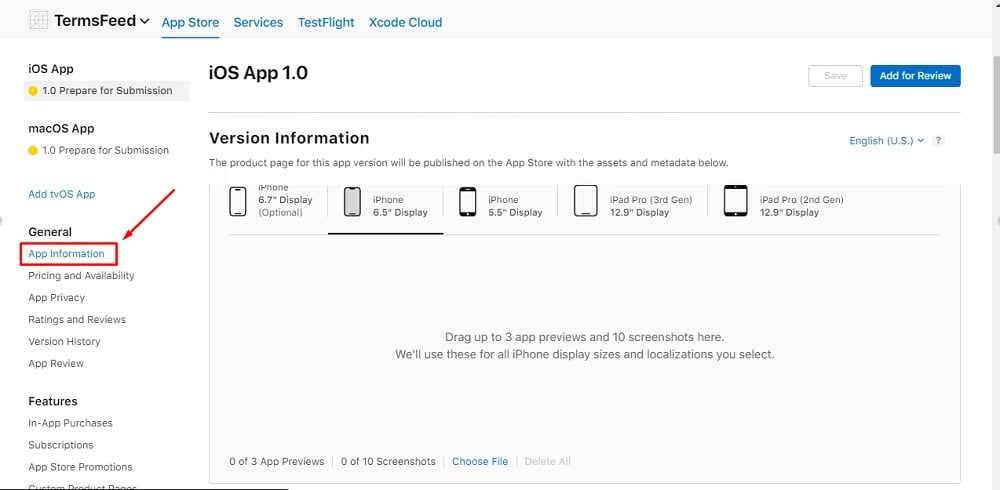
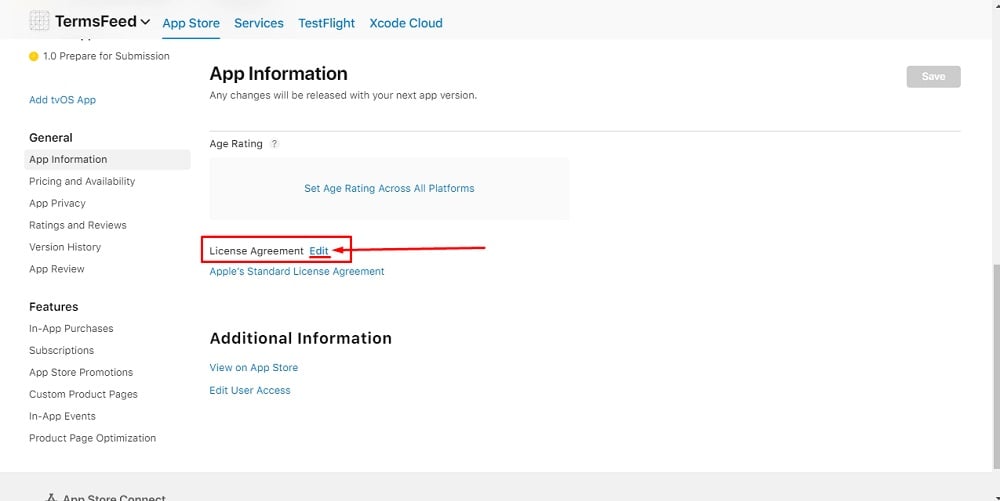
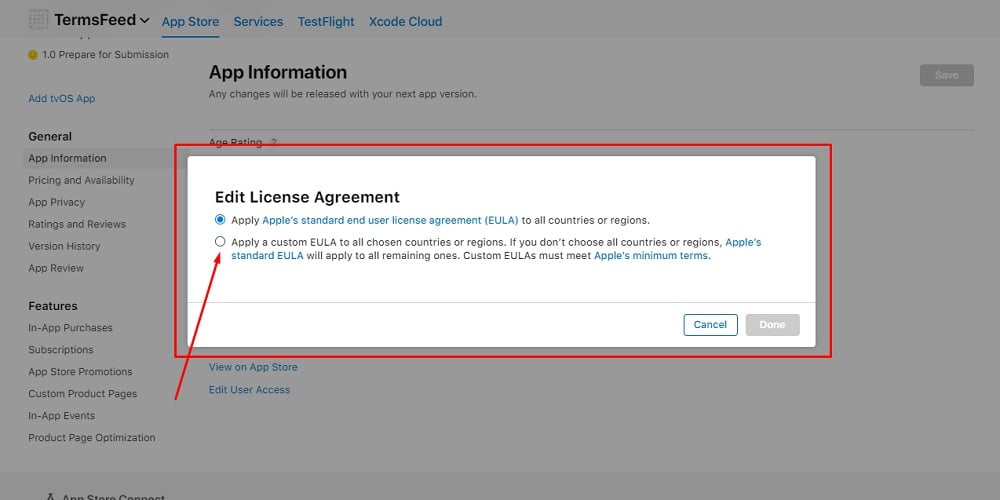
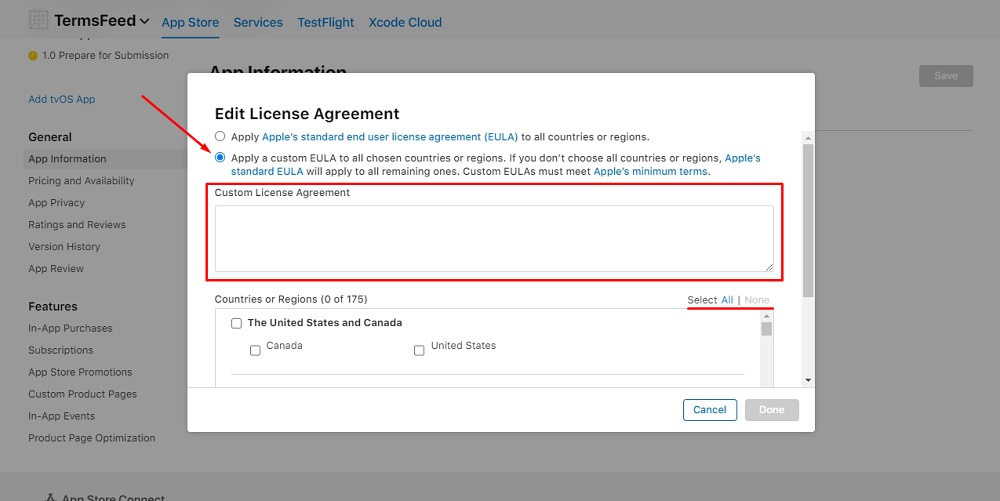
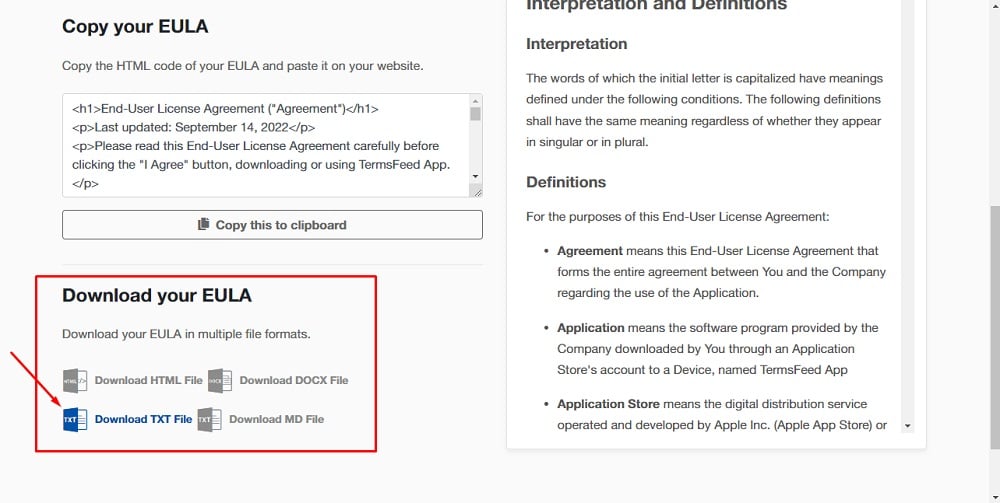
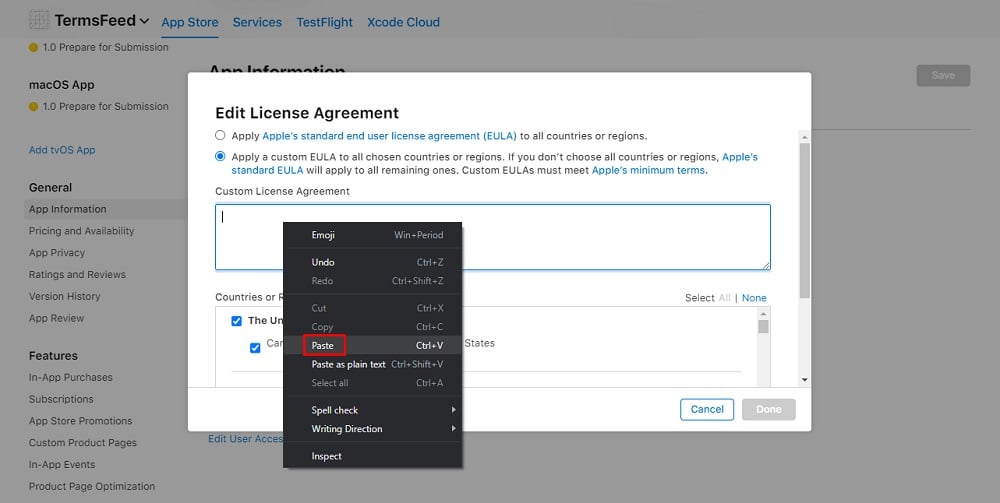
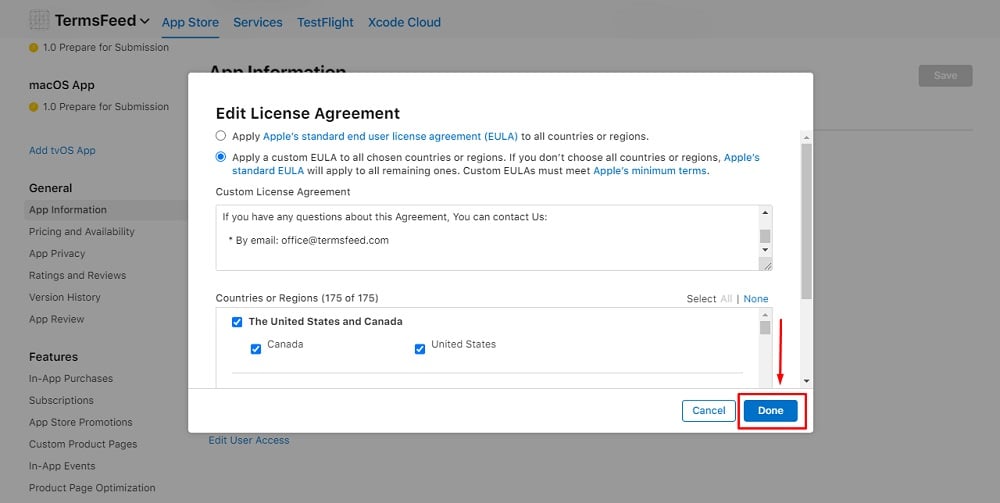
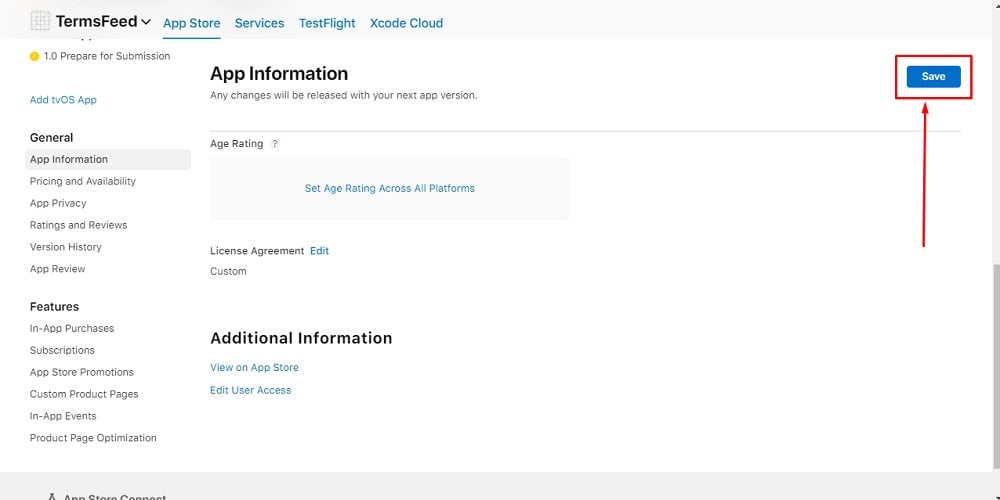
Summary
You can use Apple's standard EULA for your app, and a lot of apps choose to do this.
However, if your app is more complicated and advanced or you wish to maintain more control over the EULA terms, you may wish to include a custom EULA instead.
When creating your custom EULA, remember to follow Apple's Instructions for Minimum Terms of Developer's End-User License Agreement to stay compliant with Apple's minimum requirements. The 10 points must be addressed. While it doesn't matter what clauses you address them in, you must make sure that the relevant information is there.

Comprehensive compliance starts with a Privacy Policy.
Comply with the law with our agreements, policies, and consent banners. Everything is included.
